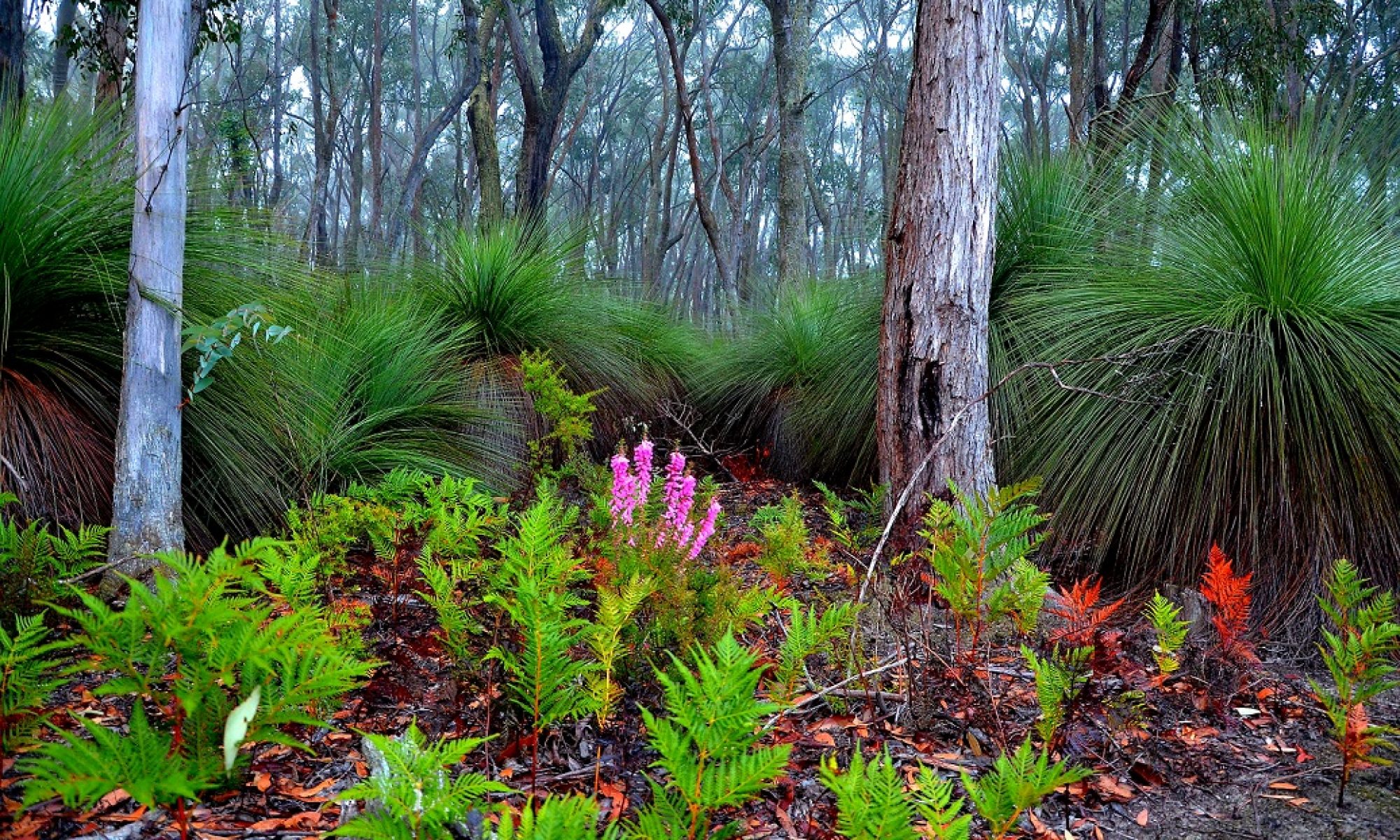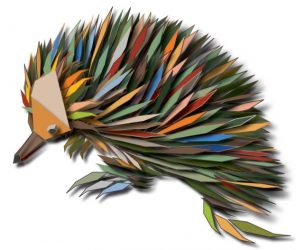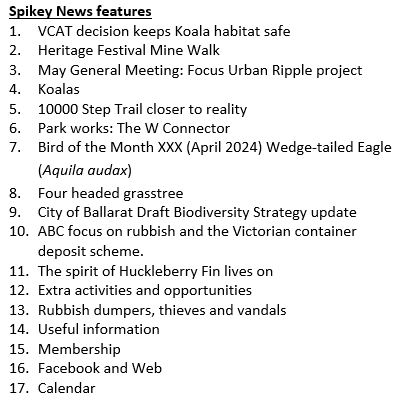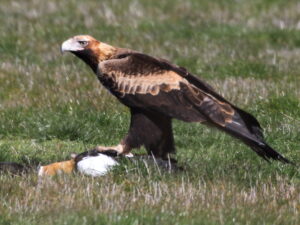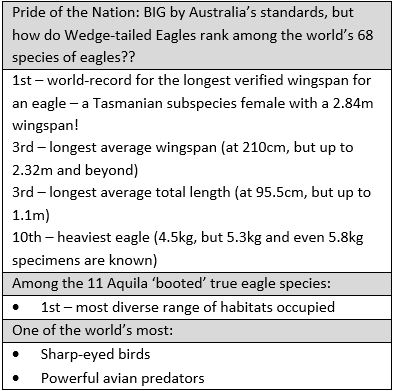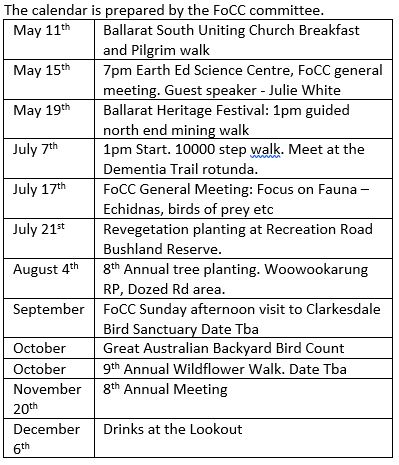- VCAT decision keeps Koala habitat intact.
The Victorian Civil and Administrative Tribunal has upheld a City of Ballarat decision to refuse a 24-lot subdivision application in Haymes Rd, Mt Clear.

The VCAT hearing was held over seven days in February and March involving the applicant New Home Shop Pty Ltd, City of Ballarat, several expert witnesses and seven local objectors including the FoCC. The FoCC and local residents objected to the original plan of subdivision to moonscape the site of trees, including 14 critically endangered Yarra Gums. Later versions of the subdivision plan still had over 60% of the Koala habitat and over half the Yarra Gums, proposed to be removed. The VCAT decision highlighted that the applicant’s subdivision design did not address the complexity of the site, the native vegetation on the site adequately and failed to resolve Bushfire Management Overlay issues on the site. The upholding of the Councils refusal for a subdivision permit, bodes well for future protection of biodiversity on the east side of Ballarat. The full VCAT report can be read at:
http://www.austlii.edu.au/cgi-bin/viewdoc/au/cases/vic/VCAT/2024/313.html

- Heritage Festival Mine Walk
1pm Sunday 19th May 2024.
Start and end point – CHW Wilson St Water Tanks, Wilson St, Canadian. (Red dot on map below)
Distance – 8.3 kilometres time, approximately 3+ hrs
Trail Condition – The trail is on undulating bush tracks and trails. It crosses gullies, creeks and occasional steep hills.
Solid footwear, rain and wind proof clothing is essential. Recommended to carry water and any other personal needs. There are no facilities along the way. Light refreshments at the end. A bifold walk map will be handed out at the start.

- May General Meeting: Focus “Urban Ripple” project
The focus of the 7pm 15th May FoCC general meeting will be the recent Victorian Government $701000 Urban Ripple waterways restoration project.
The Guest Speaker will be Ms Julie White, Project Manager of the Urban Ripple project. The project plan is to restore 13 sites along Ballarat waterways with extensive weed control, then replanting with local species.
The project was awarded to the Bunanyung Landscape Alliance in partnership with The Yarrowee Leigh Catchment Group (YLCG). The FoCC is a member of the YLCG and has four sites designated for restoration works in 2025 and 2026. These are: Lal Lal Drain, Canadian Creek, Soapy’s Dam and Sailors Gully Creek. The presentation will outline how the project will unfold over the next 2 years and how friends may become involved in the program.
FoCC General Meeting
7pm Wednesday 15th May 2024
Earth Ed Science Centre
Olympic Avenue, Mt Clear. All welcome.
- Koalas
October to March is Koala breeding season and peak sightings time. If you see, hear or find scat from a Koala, please send the information containing the when, where, and how to: foccinfo@gmail.com. Images are gold.
All Koala sightings are entered into the iNaturalist online data base.
- 10000 step trail closer to reality
Recent works on Baileys Rd and Penny Leaf track have created a 10000-step trail in Woowookarung Regional Park.
The idea of 10000 step trail was first proposed by the FoCC in 2017.

The FoCC 2017 submission to the Woowookarung Regional Parks Master Plan consultation, proposed a 10000-step central trail linking the Lookout, Amphitheatre and Visitor Centre as shown above. Note: The Dementia Trail Car Park and Rotunda have effectively become the visitor centre at present. The Woowookarung Regional Parks Strategic Directions Plan 2018 adopted the request and described the trail as:
Central circuit (The 10,000 Steps). This circuit also forms the 10,000 Steps circuit, which is proposed to connect many of the exciting and unique features of the park Ref: Page 60 WRP Strategic Directions Plan 2018
The establishment of the Dementia Trail and the Grasstree Nature Trail within the Central Circuit (10000 step trail) and the reconstruction of Baileys Rd, means the 10000-step trail is now a reality on the ground as the map below shows.

“The Amphitheatre: Located on the 10,000 Steps circuit, the Amphitheatre (named by the Friends of the Canadian Corridor) sits within the topography of the park overlooking Ballarat. There is an opportunity to provide lookout platforms, picnic tables and seating that offer views across the regenerating former plantation blocks towards Ballarat. This location may provide an opportunity to tell the important story of the forest’s regeneration and the strategies to reunite the forest fragments such as the ecological corridors. Other stories include the water races on the nearby hillside.”
Ref: Page 62 WRP Strategic Directions Plan 2018
- Park works: The W Connector
Parks Victoria have upgraded a connecting track between Baileys Rd and the W Track. The track has been resurfaced with a 100m long raised trail section across boggy ground.

Just completed Connector trail. Image 24th April 2024.
- Bird of the Month XXX (April 2024)
Wedge-tailed Eagle (Aquila audax)
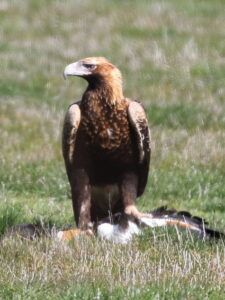
Milestone BotM editions such as this, call for a BIG, blockbuster write-up! And no bird is bigger in size, spirit, or reputation than the mighty Wedge-tailed Eagle! A popular childhood favourite (including that of this bird nerd!), this majestic bird is proudly shrouded in First Nations’ cultural significance, most notably being revered by Indigenous Victorians as the inspiration behind the Dreamtime legend of Bunjil. Elsewhere, ‘Wedgies’ features prominently in pop culture iconography. Physically, Wedge-tailed Eagles are imposing, growing to a massive total length of ~1m, with wingspans of 2.3m, and weights of ~5kg. Such large dimensions rank it as Australia’s largest raptor (bird of prey), outsizing the second-largest, the White-bellied Sea-Eagle, by 15% in total length, and 25% in weight, while ‘Wedgies’ are over four times heavier than the other of Australia’s three eagles, the Little Eagle (itself smaller than several other non-eagle Australian raptors). Certainly, this sheer size lends itself to Wedgies exuding an aura of fearlessness and all-conquering domination of the food chain, which is possibly the reason for its scientific epithet of ‘audax’ which means ‘bold’ in Latin. Food chain aside, its aura extends to its commanding presence (very palpable!) in flight, as it soars high (regularly reaching elevations of 1,800m, or as high as 3,000m), gracefully, and powerfully, completely resistant to even strong winds. Let me tell you, this is an awe-inspiring, larger-than-life, mega-bird!
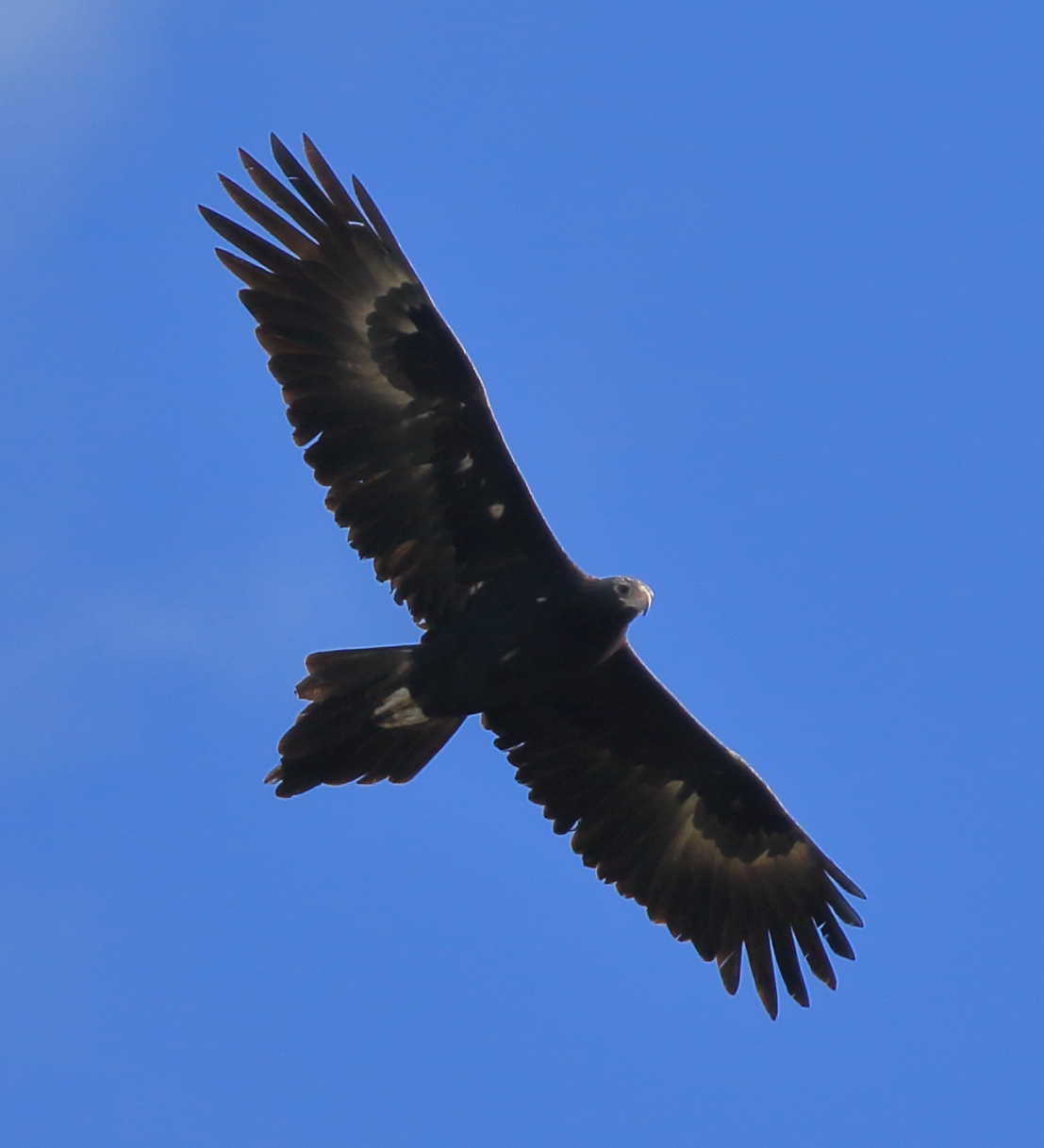 The identifying features of the Wedge-tailed Eagle are of course its long, diamond-shaped tail; long, broad wings, with prominent ‘fingers’ (the wingtip feathers are more technically known as ‘primaries’), often held upswept in a shallow ‘V’; ‘trousers’ fully-feathered down to the off-white feet; and long, ivory-coloured bill. The plumage darkens with age throughout at least their first 10 years (breeding age at 6-7 years), going from mid or chocolate brown, to blackish brown. Juveniles have paler tones of golden-brown or reddish brown on their crown, nape, mantle, and shoulders down to mid outerwing, while the breast feathers are fringed with those paler tones, and the underwings are faintly barred. As with most raptors, females are larger than males, but otherwise the sexes are visually indistinguishable.
The identifying features of the Wedge-tailed Eagle are of course its long, diamond-shaped tail; long, broad wings, with prominent ‘fingers’ (the wingtip feathers are more technically known as ‘primaries’), often held upswept in a shallow ‘V’; ‘trousers’ fully-feathered down to the off-white feet; and long, ivory-coloured bill. The plumage darkens with age throughout at least their first 10 years (breeding age at 6-7 years), going from mid or chocolate brown, to blackish brown. Juveniles have paler tones of golden-brown or reddish brown on their crown, nape, mantle, and shoulders down to mid outerwing, while the breast feathers are fringed with those paler tones, and the underwings are faintly barred. As with most raptors, females are larger than males, but otherwise the sexes are visually indistinguishable.
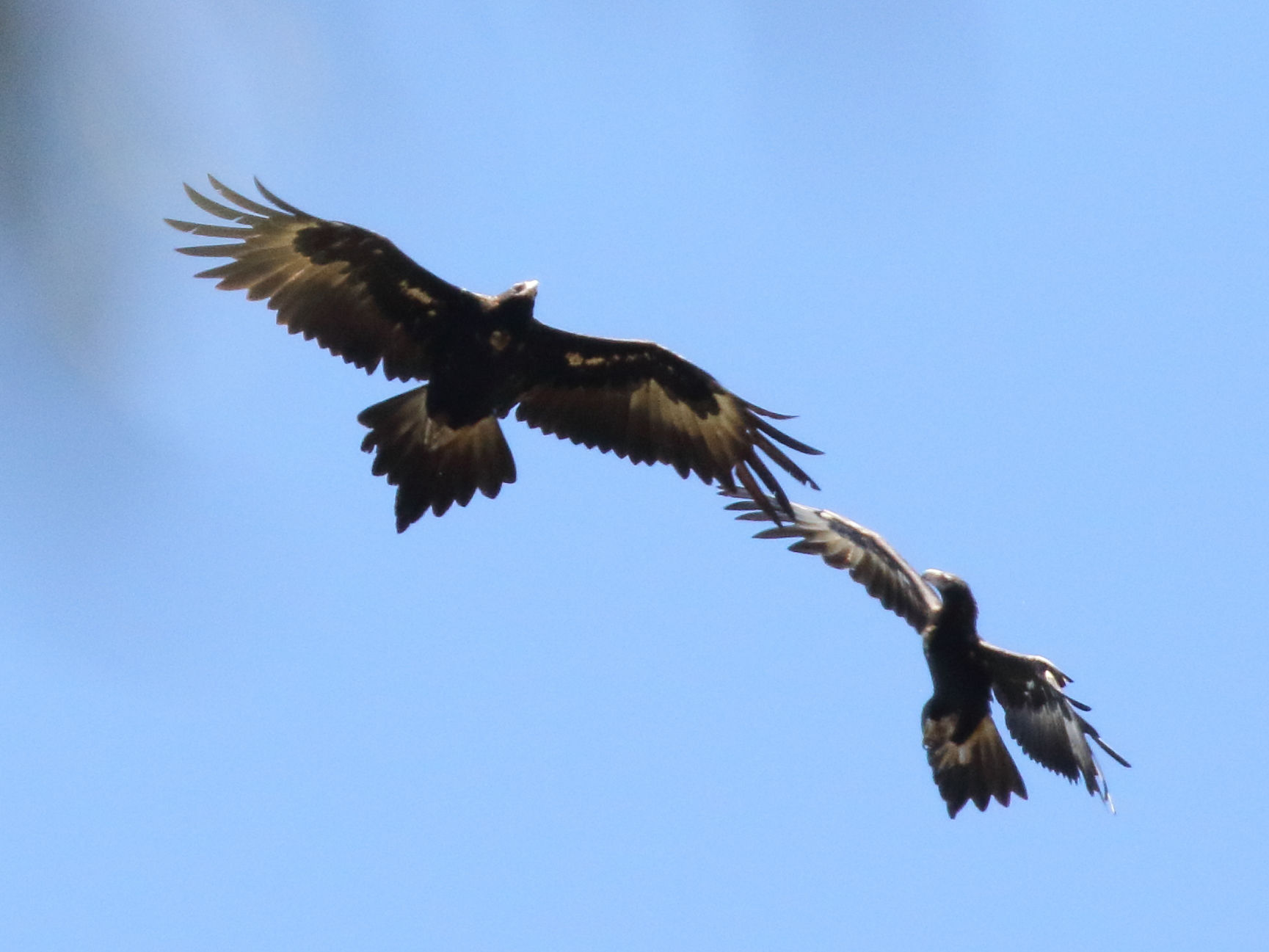
Wedge-tailed Eagles tend to be silent, but may utter ‘disyllabic and wavering trill-like whistles and yelps in social/territorial contexts’. Other cues to alert you to its presence are the recurring dynamic of aggressive and vociferous mobbing tactics by smaller birds, such as magpies, ravens, lapwings, Magpie-larks, Willie Wagtail, butcherbird, falcons, and Brown Goshawks, etc., which harass Wedgies as an anti-predator alarm system.
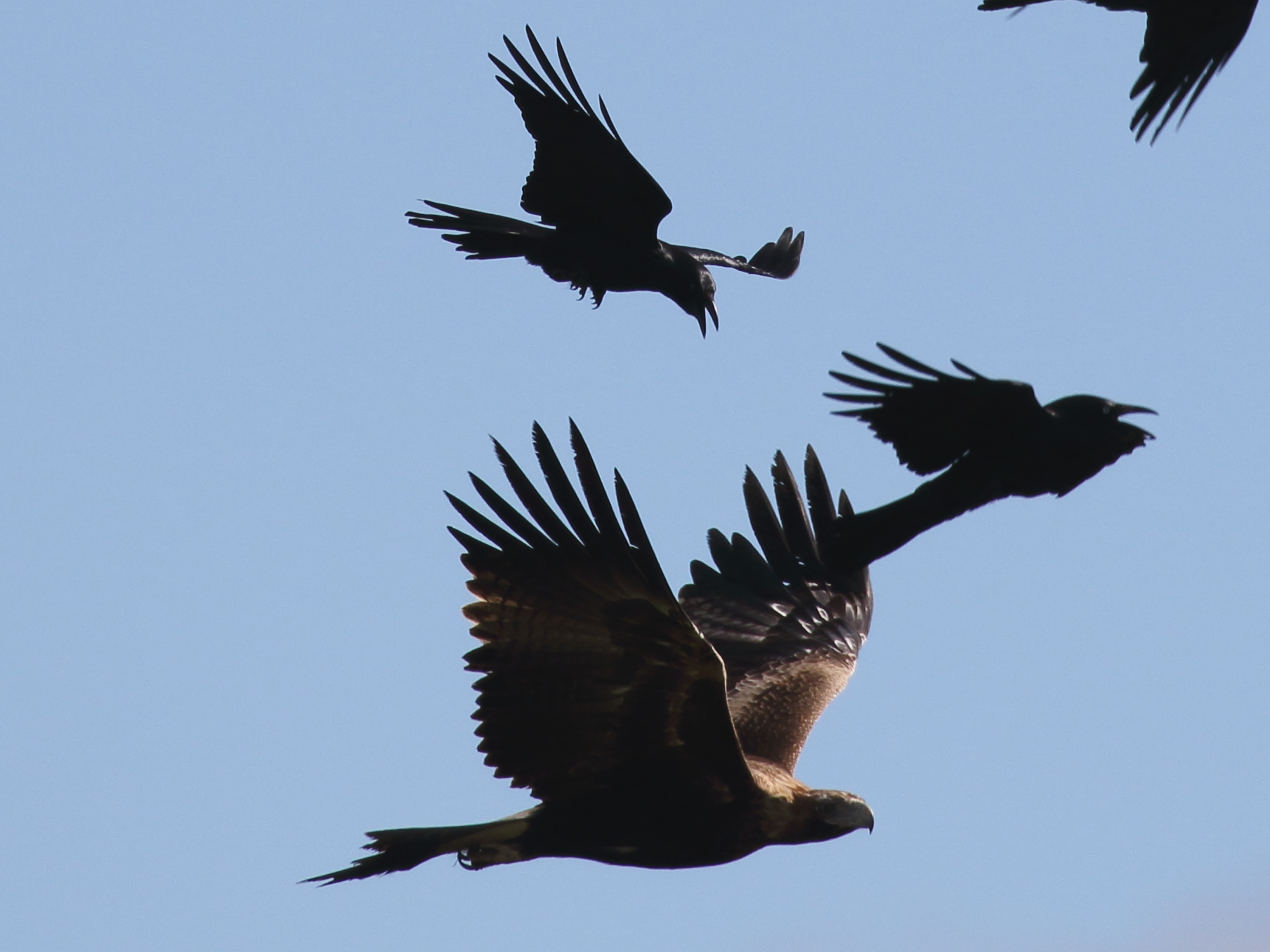
Wedge-tailed Eagles are widespread across the Australian mainland and Tasmania (also New Guinea), inhabiting a wide range of habitats throughout, most notably thrive in treed open country, woodland, and forests. Favourable conditions for a habitat, include: availability of tall tree(s) to support their ample nest(s), and provide a high vantage point; abundance of mammalian prey; and undulating terrain (e.g. hills, mountains) as these topographic features promote the updraughts on which ‘Wedgies’ so routinely soar.
Wedge-tailed Eagles exploit a diverse range of prey species. Primarily, they target mammalian prey, with dietary staples including rabbits, and brushtail possums (which Wedgies extract from tree cavities). Secondary diet options include hares, ringtail possums, wallabies, kangaroos (hunts may be cooperative amongst 2-15 Wedgies), birds of all sizes (e.g. galahs, cockatoos, ducks), lizards (e.g. Bearded Dragon), and roadkill. Supplementing their diet, in infrequent/rare cases of opportunism, are rodents, feral cats, foxes, Dingo, bats (both flying-fox and microbat), Koalas, raptors, Short-beaked Echidna, Platypus, venomous snakes, fish, Cane Toads, and insects. The Wedgies’ formidability is such that almost everything with the exception of humans (no recorded human deaths), pythons, crocodiles, and large undulates, is able to be overpowered. Fortunately, despite common misconception, livestock is generally only exploited as carrion (i.e. cleaning up the dead). Wedgies can carry away prey of at least 5kg, but heavier prey may be eaten in situ by up to 20 Wedgies, or covered with vegetation debris and cached for later.
Wedge-tailed Eagles are monogamous and pairs breed for life. Breeding season is April through September, but this may vary from location to location, and year to year, dependent on local food availability (cases are known where pairs defer breeding for four years straight). Breeding pairs may engage in aerial courtship, whereby they may choreograph loop-de-loop manoeuvres – a sight to behold! Both parents contribute to nest-building, incubation, and young-feeding duties. Clutch sizes are typically 1 or 2 eggs, but sometimes up to 4. Wedgie eggs (150g) are 3 times larger than chicken eggs, and a clutch of three eggs would see the expectant mother carrying 10% of her body weight in eggs. Incubation lasts 45 days, and the male will primarily deliver food to the female, and occasionally relieve her of incubation duties. Fledging occurs at 67-95 days. Up to two-thirds of Wedgies may die sometime between fledging and 3-5 years, but adults have quite low mortality rates and can live for the better part of half a century (certainly, captive individuals have been known to live to ~40 years). Nests are large (typically 1.8m wide) structures of sticks, generally reused year after year for decades, and progressively reinforced with sticks to the point where the nest may be 3.9m deep and a hefty 400kg! The nest interior is shallow (~30cm deep), and lined with green leaves and twigs. The nests tend to be in the tallest tree and/or a tree on elevated ground (for surveillance purposes), but dwarf trees (1-2m), telegraph poles, power pylons, cliff ledges, rock piles, and hills are all known, occasional alternative nest sites. Nests may number 2-3 per pair to provide alternative nurseries. Occasionally, Wedgies may inherit and upsize disused Whistling Kite nests, while Wedgies’ disused nests may be inherited by Pacific Black Ducks, falcons or owls, and active nests may even support nesting co-tenants such as finches, pardalotes, brusthtail possums.
Wedge-tailed Eagles are classified as ‘Least Concern’ globally, ‘Endangered’ federally, and ‘Secure’ in Victoria, but are said to be ‘Increasing’ in population trend. The species’ threats are illegal poisoning and shooting; collisions with cars (owing to its scavenging habit), powerlines, and wind turbines; and natural disasters such as fire and drought for its potential to reduce nest site and food availability.
Next time you wander through Woowookarung Regional Park (or adjacent farmland), or another local forest patch, keep a lookout (remember to observe the cues of magpies and other harassers) above for flyovers by the majestic, pest-controlling, carcass removalist, awe-inspiring mega-birds that are the mighty Wedge-tailed Eagle!
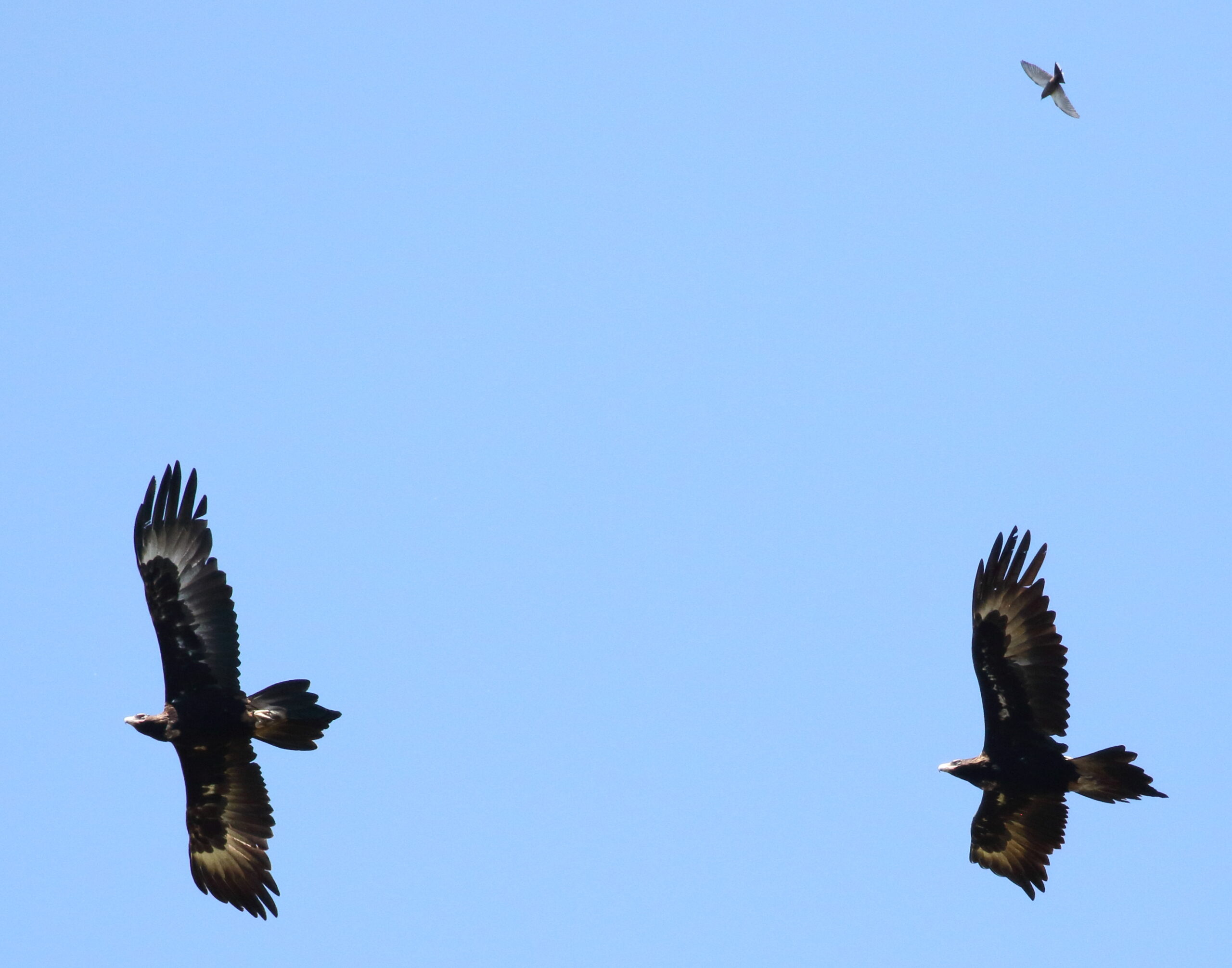 A pair of eagles and a tiny bird above right, seeing them off…
A pair of eagles and a tiny bird above right, seeing them off…
Author note: FoCC Committee member and co-admin of FoCC’s Facebook and webpage, Joel Ellis is the resident bird nerd, amateur Powerful Owl researcher, and editor of FoCC’s (co-funded) ‘Indigenous [Species] of Southern Ballarat’ brochure series. Joel has studied birds up to Honours degree level, is a professional ecological consultant (ornithologist), and member of BirdLife Australia (Ballarat branch).
- Four headed Grasstree
Grasstrees are arguably a headline feature of Woowookarung Regional Park. Most Austral Grasstrees are single headed.
This most unusual four headed grasstree with matching spikes was observed west of Boak Rd in Mt Clear recently.

- City of Ballarat Draft Biodiversity Strategy update
The draft Biodiversity Strategy was put for consultation at the beginning of April. The consultation is due to close at the end of April. After a review of the My Say and submissions the strategy should go to the Council for adoption in June.
The FoCC has made a submission which will be posted on the FoCC website in due course.

- The spirit of Huckleberry Fin lives on.
Spotted south of Recreation Road in the regrowth forest on ex plantation land.
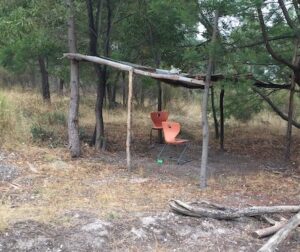
- ABC focus on rubbish and the Victorian container deposit scheme.
ABC Ballarat contacted the FoCC about rubbish and the Victorian container deposit scheme. The ABC enquiry was about whether deposit scheme had had any discernible impact. A quick Vox Pop of members elicited the following collective response:
- Friends reported less drink bottles and cans in our Parks and along roadsides.
- The friends were unsure as to whether less bottles and cans are being discarded or that more are being picked up by children, families and groups for fundraising.
- Local Park Rangers have observed a drop in bottle and can litter at places like the Lookout in Woowookarung Regional Park.
- One source of rubbish that has reduced considerably is the plastic straw, perhaps as a result of the ban of single use straws in February 2023.
- Friends feedback noted that household rubbish and building waste along roads is still a problem. Building sites generate a lot of waste where it is often blown onto roads and adjacent parks and forest. Suggestions were for more to be done about secure waste skip bins, even fines for overflowing skip bins on sites.”
- Extra activities and opportunities
Ballarat South Uniting Church Breakfast and Pilgrim walk. The walk is 8.3kms long from Buninyong Uniting Church, through Union Jack reserve and the forest to the North of Buninyong and returning via the Geelong Rd shared trail. Good footwear, all weather clothing, drink bottle essential.
Details below:
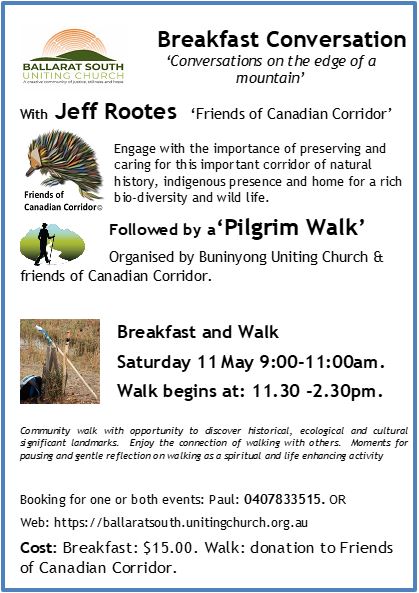
- Rubbish dumpers, thieves and vandals
The FoCC encourages Park friends to report track vandals, rubbish dumpers, wood thieves and other suspicious activity to Parks Victoria on 13 1963 or email: woowookarung@parks.vic.gov.au
In emergency situations please call 000
If an offender is spotted, please note vehicle registration details as vehicle identification is most helpful, plus location and details.
Useful information: Parks Victoria Woowookarung email address: woowookarung@parks.vic.gov.au
- City of Ballarat wildlife information:
https://www.ballarat.vic.gov.au/me/pets-and-animals/wildlife - Wildlife Victoria (03) 8400 7300
- DEECA wildlife issues reporting information
Report wildlife crime to Crime Stoppers Victoria on 1800 333 000.
Report any wildlife at immediate risk of deliberate harm or neglect to 136 186. Other matters relating to wildlife and wildlife management should use the 136 186 too.
The Help for Injured Wildlife tool will help you locate and contact the closest relevant wildlife carers and rescue and rehabilitation organisations to help the injured wildlife.
The main point to reiterate is for any matters related to wildlife crime, to call Crime Stoppers.
- Membership Membership runs from 1st January to 31st December each year, Membership fee is $20 per year. New members after July are credited to the next year. Membership forms are available online or email foccinfo@gmail.com
- FoCC Facebook and webpage
www.facebook.com/friendsofcanadiancorridor/
Rob is overseeing the webpage webmaster@focc.asn.au
The FoCC has over 1100 friends following us on Facebook and growing. Welcome to all new friends. Feel free to pass on to other friends and press the like button.
- 2024 Proposed Calendar
